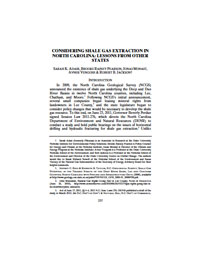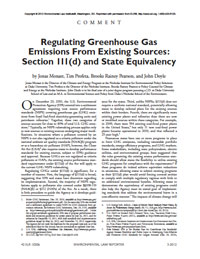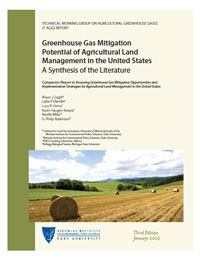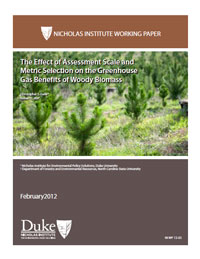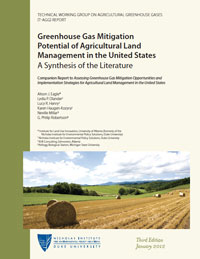Publications
Considering Shale Gas Extraction in North Carolina: Lessons from Other States
Because North Carolina has no active oil and gas production and no existing regulatory framework for this industry, it has a unique opportunity to build a program from the ground up. This article in the Duke Environmental Law & Policy Forum looks at the environmental and health concerns surrounding hydraulic fracturing to extract natural gas trapped below the ground, and shares regulatory approaches other states are taking to reduce these risks. Further, it focuses on several measures North Carolina lawmakers should understand when considering whether, and under what conditions, to allow shale gas extraction in the state.
Regulating Greenhouse Gas Emissions from Existing Sources: Section 111(d) and State Equivalency
On December 9, 2011, the Nicholas Institute for Environmental Policy Solutions convened a broad range of stakeholders to explore the legal and policy issues presented by the regulation of greenhouse gas (GHG) emissions under 111(d) (existing source performance standards) of the Clean Air Act. The workshop focused primarily on the options for states to demonstrate that existing GHG policies are equivalent to the 111(d) requirements. The Nicholas Institute distributed this document to workshop participants prior to the event to provide a framework for the issues that would be discussed. Nothing in this document should be interpreted as expressing the Institute’s opinion of the path the EPA should take on any given issue.
What Makes Carbon Work? A Sensitivity Analysis of Factors Affecting Forest Offset Viability
Early implementation experience and a handful of empirical analyses in the literature indicate that the supply of forest carbon offsets may be constrained by, among other factors, transaction costs, access to markets, and carbon accounting rules and regulations. To more fully explore this issue, we use a forest growth and carbon accounting model to assess the relative influence of several key accounting, financial, and market variables on forest carbon offset project viability. We find that project performance, indicated by sequestration rate and project profitability, varies widely across the three project/forest type combinations evaluated here. The effects of carbon price and project length vary in both magnitude and direction from project to project. Project accounting considerations, including baseline establishment method and deductions for “leakage” and other factors, tend to figure prominently in each project, but vary in their absolute effect. These initial results suggest that choice of accounting protocol is a critical decision facing landowners considering forest offset projects. Results also suggest that a one-size-fits-all accounting approach may fail to maximize either landowner participation or the representation of forest types or management systems.
Greenhouse Gas Mitigation with Agricultural Land Management Activities in the United States—A Side-by-Side Comparison of Biophysical Potential
Responsible for 6% of U.S. greenhouse gas (GHG) production, agricultural land use has significant potential to reduce these emissions and capture additional carbon in the soil. Many different activities have been proposed for such mitigation, but assessments of the biophysical potential have been limited and have not provided direct comparison among the many options. We present an in-depth review of the scientific literature, with a side-by-side comparison of net biophysical GHG mitigation potential for 42 different agricultural land management activities in the United States, many of which are likely applicable in other regions. Twenty of these activities are likely to be beneficial for GHG mitigation and have sufficient research to support this conclusion. Limited research leads to uncertainty for 15 other activities that may have positive mitigation potential, and the remaining activities have small or negative GHG mitigation potential or life-cycle GHG concerns. While we have sufficient information to move forward in implementing a number of activities, there are some high-priority research needs that will help clarify problematic uncertainties.
The Effect of Assessment Scale and Metric Selection on the Greenhouse Gas Benefits of Woody Biomass
Recent media attention has focused on the net greenhouse gas (GHG) implications of using woody biomass to produce energy. In particular, a great deal of controversy has erupted over the biomass accounting techniques used to evaluate these GHG effects. This paper informs the present debate over the GHG effects of woody biomass use by conducting a comparative analysis of these accounting techniques. It compares these techniques in a hypothetical scenario in which coal-fired power plants in Virginia add woody biomass to their fuel mix—a process known as “cofiring.” It finds that these techniques strongly influence the calculated GHG balance. The paper also assesses the relative effect of the accounting approach on differences in GHG balance, and concludes with implications for policy makers.
Determining the Least-Cost Investment for an Existing Coal Plant to Comply with EPA Regulations under Uncertainty
Low natural gas prices and forthcoming Environmental Protection Agency (EPA) regulations for coal plant emissions, coal wastes, and thermal-generation cooling systems are forcing utilities and utility regulators to decide whether to retrofit or to retire and replace existing coal plants. To help utility commissions and other interested parties make informed investment decisions and quantify cost risk for ratepayers, researchers at Duke University will make the Risk Based Decision Model available to the public. The model can be employed to estimate the impact of abrupt changes, or “shocks,” and the cost of making “bad” investments that are later abandoned. To demonstrate the model, this paper models the least-cost investment decision for Louisville Gas and Electric’s Mill Creek coal-fired power plant to meet the forthcoming EPA regulations under uncertainty using publicly available data.
Stacking Ecosystem Services Payments: Risks and Solutions
Healthy ecosystems provide many services to society, including water filtration, biodiversity habitat protection, and carbon sequestration. A number of incentive programs and markets have arisen to pay landowners for these services, raising questions about how landowners can receive multiple payments for the ecosystem services they provide from the same parcel, a practice known as stacking. Stacking can provide multiple revenue streams for landowners and encourage them to manage their lands for multiple ecosystem services. However, if not well-managed, it may also lead to a net loss of services.
Reducing the Energy Penalty Costs of Postcombustion CCS Systems with Amine-Storage
Carbon capture and storage (CCS) can significantly reduce the amount of CO2 emitted from coal-fired power plants, but its high capital and operating costs are an important barrier. In this paper we analyze one alternative to reduce operating costs of amine-based CCS systems.
Green Economy in a Blue World
This report highlights how ecological health and economic productivity of marine and coastal ecosystems, which are currently in decline around the globe, can be boosted by shifting to a more sustainable economic paradigm that taps their natural potential. Released by the United Nations Environment Programme and partners, it further highlights how the sustainable management of fertilizers would help reduce the cost of marine pollution caused by nitrogen and other nutrients used in agriculture, which is estimated at $100 billion per year in the European Union alone.
Greenhouse Gas Mitigation Potential of Agricultural Land Management in the United States: A Synthesis of the Literature (Third Edition)
This document, now in its third edition, is a comparision report to the T-AGG report Assessing Greenhouse Gas Mitigation Opportunities and Implementation Strategies for Agricultural Land Management in the United States. The third edition updates the side-by-side comparision of the biophysical greenhouse gas mitigation potential of 42 agricultural land management activities with newly available and previously unincluded data from field experiments, modeling, and expert review. Activities with sufficient research estimates of mitigation potential are now all derived from original individual data points of side-by-side experiments (previous editions included expert and modeling estimates and applied different weighting factors).

